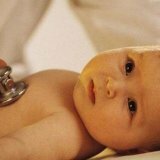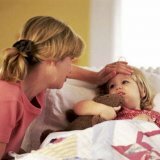Angina in an infant

Angina in an infant is caused in most cases by staphylococci or streptococci, as well as by adenoviruses. Where do they come from? Most often, bacteria "doze" on the mucous in the baby's airways and are activated when immunity is weakened. But they can also get into the body of a nursing baby from the outside, for example, from sick adults who find themselves near a crumb at home or on the street.
Types of angina in newborns
Physicians distinguish several types of this disease. Each has its own characteristics. They must be known and taken into account when prescribing treatment.
Catarrhal angina. In young children is more common. The temperature is normal or increases slightly. On the neck of the crumbs you can see reddened tonsils. The child can not swallow normally. With proper treatment, such an angina will take place in 5-7 days.
Follicular angina occurs in a more severe form. The temperature can jump up sharply, and it hurts not only the neck, but also the head, joints, muscles. There is abundant salivation, enlarged lymph nodes under the lower jaw, tonsils appear suppuration.
Fungal sore throat. It often occurs in those children, whose body can not cope with viruses due to weak immunity. To the common symptoms, the disturbed intestinal microflora is attached.
Diphtheria angina. This form requires increased attention, since diphtheria itself is an extremely dangerous infectious disease. The source of the infection is diphtheria bacillus. Having fallen on the mucous membrane of the mouth and nose, it actively multiplies, poisoning the body of the infant. Symptoms of such a sore throat are similar to those of a common cold. Only after 3-5 days, with the wrong treatment, which does not work, parents call the doctor. But with diphtheritic angina such a pause is dangerous, because during this time there can be complications. Here it is necessary to introduce antidiphtheria serum. Treatment should be conducted in an infectious diseases hospital.
Common symptoms of angina in a child
Usually, angina in infants starts suddenly. The temperature rises sharply, reaching 39-410 ° C.Cervical and submandibular lymph nodes increase - this can be seen by touch. The little one is naughty, it pains him to swallow, because of what he refuses to eat. On the tonsils can be seen white or yellow coating.
Treatment of angina in infants
At the first symptoms of angina, call a doctor at the house. If the temperature is above 38.50С, before the doctor comes to the sick child, you can give an antipyretic medicine. All other medications are prescribed only by a specialist. With the development of purulent plaque, antibiotic treatment can not be avoided.
Offer the baby a warm drink( you can compote from dried fruits).In the absence of temperature, you can give overnight warmed milk with a melted piece of butter. This drink - a good helper in the fight against any angina in children.
How to care for a sick child
• A baby needs to provide bed rest. Even if the crumb against( asking to "walk" on the pens) - do not go on his way. Soon he will feel that he wants to rest.
• If you experience high temperatures, be sure to drink more with any liquid that is available. So toxins will be washed out from the body, and dehydration of the body will not occur. Drinking can be given from a syringe, a spoon or a cup.
• You do not need to give a crumb of drinks with the content of flavors and dyes. This gives an extra load on the baby's liver, and at this time it has another task.
• The room in which the ill child is located must be ventilated several times a day and wet cleaned.
• Food should be eaten in a cleaned form or in the form of a puree, in order to facilitate the swallowing process. So eating will not deliver painful sensations.



